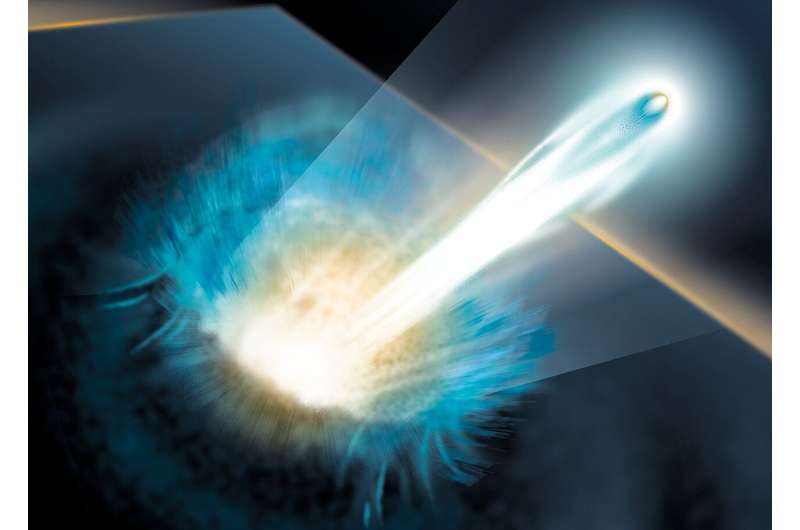This article has been reviewed according to Science X's editorial process and policies. Editors have highlighted the following attributes while ensuring the content's credibility:
fact-checked
peer-reviewed publication
trusted source
proofread
Smaller laser facility uses new method to exceed previous record for proton acceleration

The Helmholtz-Zentrum Dresden-Rossendorf (HZDR) has made a significant advance in laser plasma acceleration. By employing an innovative method, a research team managed to substantially exceed the previous record for proton acceleration.
For the first time, they achieved energies that so far have only seemed possible at much larger facilities. As the research group reports in the journal Nature Physics, promising applications in medicine and materials science have now become much likelier.
Laser plasma acceleration opens up interesting perspectives: compared to conventional accelerators, it holds the promise of more compact, more energy-efficient facilities—because instead of employing powerful radio waves to get particles moving, the new technology uses lasers to accelerate them.
The principle is that extremely short but high-intensity laser pulses fire on wafer-thin foils. The light heats up the material to such an extent that countless electrons emerge from it while the atomic cores remain in place.
As the electrons are negatively charged and the atomic cores are positive, a strong electric field is formed between them for a short time. This field can catapult a proton pulse over only a few micrometers to energies that would require substantially longer distances using conventional accelerator technology.
This technology, however, is still at the research stage: so far, it has only been possible to achieve proton energies of up to 100 MeV and only by using extremely large laser systems of which there are just a few in the world.
In order to achieve similarly high accelerator energies with smaller laser facilities and shorter pulses the team of HZDR physicists Karl Zeil and Tim Ziegler pursued a new approach. They harness a property of laser flashes that is generally seen as a flaw. "A pulse's energy doesn't kick in immediately, which would be the ideal case," reports Ziegler. "Instead, a little of the laser energy rushes ahead of it, like a kind of vanguard."
Suddenly transparent
In the new concept, it is this light rushing ahead that plays a key role. When it hits a specially manufactured plastic foil in a vacuum chamber, it can change it in a specific way. "The foil expands due to the influence of the light and gets ever hotter and thinner," Ziegler explains. "The foil effectively melts during the heating process."
This has a positive impact on the primary pulse which follows on immediately: The foil, which would otherwise largely reflect the light, suddenly becomes transparent which allows the primary pulse to penetrate more deeply into the material that it did in previous experiments.
"The result is that a complex cascade of acceleration mechanisms is triggered in the material," says Ziegler, "causing the protons contained in the film to be accelerated much more than they were by our DRACO laser."
Whereas the facility previously achieved proton energies of approximately 80 MeV, it can now generate 150 MeV—almost double. To achieve this record, the team had to conduct a series of experiments to approach the perfect interaction parameters, for example regarding the optimum thickness of the films used.
When analyzing the measurement data, the research group discovered that the accelerated particle beam had another pleasing property: The high-energy protons exhibit a narrow energy distribution, meaning that, figuratively speaking, they are all about equally fast—an advantageous feature for later applications—for which high, uniform proton energies are extremely beneficial.
Advantage: Energy efficiency
One of these applications is to investigate new radiobiological concepts for precise, gentle tumor treatment. Using this method, very high doses of radiation are applied for a very short period. For these studies, up to now, large-scale conventional therapy accelerators have mainly been used which are only available at a few centers in Germany and which are, of course, prioritized for patient treatment.
The new HZDR procedure now renders the use of compact laser systems more likely, enabling additional research groups to access these investigations and facilitate radiation scenarios, that conventional systems cannot deliver. "Moreover, today's facilities need a lot of power," says Ziegler. "Based on laser plasma acceleration they could be much more economical."
The procedure could also be used for the efficient generation of neutrons. The laser flashes can be employed to produce short, intense neutron pulses, which are of interest for use in science and technology as well as for materials analysis.
Here, too, plasma accelerators promise to significantly expand the previous fields of application. But first of all, the scientists want to refine the new method and understand it better. Among other things, they want to cooperate with other laboratories to control the process more precisely and make the technology more available. And further records are also on the agenda: energies of more than 200 MeV seem entirely possible.
More information: Tim Ziegler et al, Laser-driven high-energy proton beams from cascaded acceleration regimes, Nature Physics (2024). DOI: 10.1038/s41567-024-02505-0
Journal information: Nature Physics
Provided by Helmholtz Association of German Research Centres





















